Addressing Communication Issues Between Step-parents and Step-siblings
VerifiedAdded on 2023/01/18
|6
|1494
|63
Report
AI Summary
This report delves into the communication challenges faced by stepfamilies, exploring both verbal and non-verbal communication issues. It examines the difficulties arising between step-parents and step-children, including misunderstandings, misinterpretations, and the impact on mental and physical health. The report analyzes the connections between biological and non-biological children, highlighting how parental treatment and differing cultural backgrounds influence relationships. It also discusses the challenges faced by stepchildren as they mature, including potential financial and educational limitations, and how their involvement in family issues can affect their development. The report concludes by emphasizing the importance of understanding and addressing communication breakdowns to foster healthier family dynamics within stepfamilies, supported by references to relevant literature.

Communication issues with
step parents and step siblings
step parents and step siblings
Paraphrase This Document
Need a fresh take? Get an instant paraphrase of this document with our AI Paraphraser
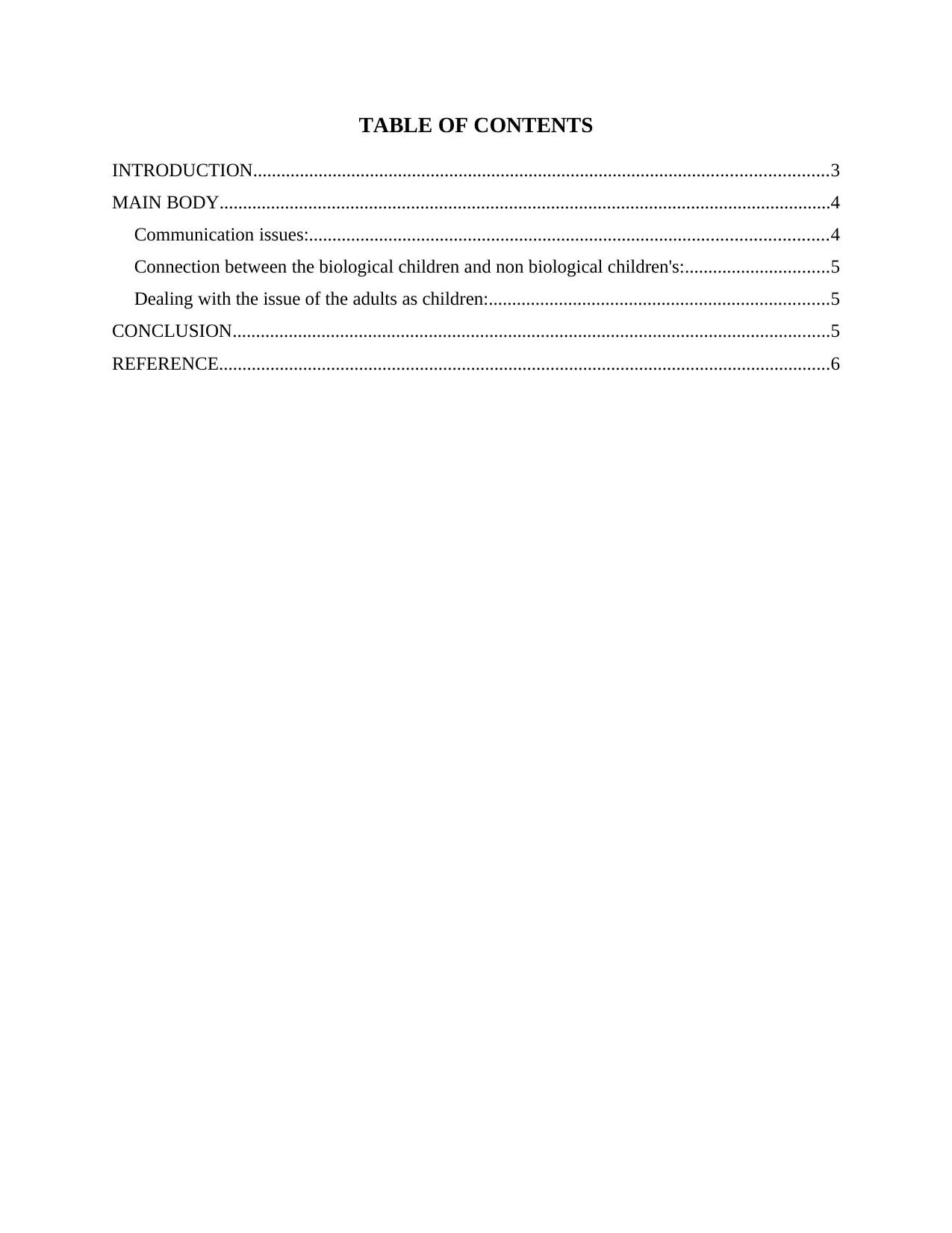
TABLE OF CONTENTS
INTRODUCTION...........................................................................................................................3
MAIN BODY...................................................................................................................................4
Communication issues:...............................................................................................................4
Connection between the biological children and non biological children's:...............................5
Dealing with the issue of the adults as children:.........................................................................5
CONCLUSION................................................................................................................................5
REFERENCE...................................................................................................................................6
INTRODUCTION...........................................................................................................................3
MAIN BODY...................................................................................................................................4
Communication issues:...............................................................................................................4
Connection between the biological children and non biological children's:...............................5
Dealing with the issue of the adults as children:.........................................................................5
CONCLUSION................................................................................................................................5
REFERENCE...................................................................................................................................6
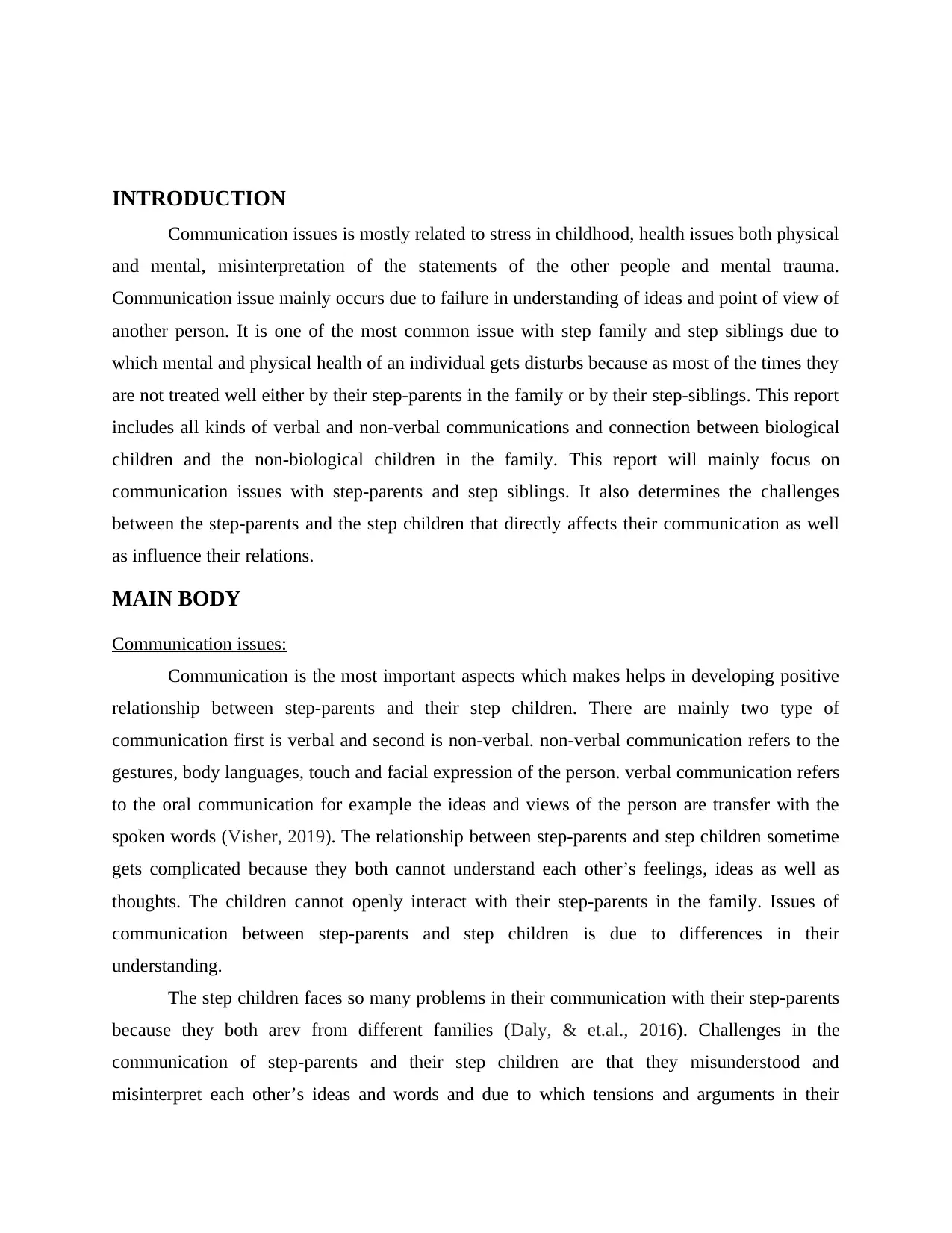
INTRODUCTION
Communication issues is mostly related to stress in childhood, health issues both physical
and mental, misinterpretation of the statements of the other people and mental trauma.
Communication issue mainly occurs due to failure in understanding of ideas and point of view of
another person. It is one of the most common issue with step family and step siblings due to
which mental and physical health of an individual gets disturbs because as most of the times they
are not treated well either by their step-parents in the family or by their step-siblings. This report
includes all kinds of verbal and non-verbal communications and connection between biological
children and the non-biological children in the family. This report will mainly focus on
communication issues with step-parents and step siblings. It also determines the challenges
between the step-parents and the step children that directly affects their communication as well
as influence their relations.
MAIN BODY
Communication issues:
Communication is the most important aspects which makes helps in developing positive
relationship between step-parents and their step children. There are mainly two type of
communication first is verbal and second is non-verbal. non-verbal communication refers to the
gestures, body languages, touch and facial expression of the person. verbal communication refers
to the oral communication for example the ideas and views of the person are transfer with the
spoken words (Visher, 2019). The relationship between step-parents and step children sometime
gets complicated because they both cannot understand each other’s feelings, ideas as well as
thoughts. The children cannot openly interact with their step-parents in the family. Issues of
communication between step-parents and step children is due to differences in their
understanding.
The step children faces so many problems in their communication with their step-parents
because they both arev from different families (Daly, & et.al., 2016). Challenges in the
communication of step-parents and their step children are that they misunderstood and
misinterpret each other’s ideas and words and due to which tensions and arguments in their
Communication issues is mostly related to stress in childhood, health issues both physical
and mental, misinterpretation of the statements of the other people and mental trauma.
Communication issue mainly occurs due to failure in understanding of ideas and point of view of
another person. It is one of the most common issue with step family and step siblings due to
which mental and physical health of an individual gets disturbs because as most of the times they
are not treated well either by their step-parents in the family or by their step-siblings. This report
includes all kinds of verbal and non-verbal communications and connection between biological
children and the non-biological children in the family. This report will mainly focus on
communication issues with step-parents and step siblings. It also determines the challenges
between the step-parents and the step children that directly affects their communication as well
as influence their relations.
MAIN BODY
Communication issues:
Communication is the most important aspects which makes helps in developing positive
relationship between step-parents and their step children. There are mainly two type of
communication first is verbal and second is non-verbal. non-verbal communication refers to the
gestures, body languages, touch and facial expression of the person. verbal communication refers
to the oral communication for example the ideas and views of the person are transfer with the
spoken words (Visher, 2019). The relationship between step-parents and step children sometime
gets complicated because they both cannot understand each other’s feelings, ideas as well as
thoughts. The children cannot openly interact with their step-parents in the family. Issues of
communication between step-parents and step children is due to differences in their
understanding.
The step children faces so many problems in their communication with their step-parents
because they both arev from different families (Daly, & et.al., 2016). Challenges in the
communication of step-parents and their step children are that they misunderstood and
misinterpret each other’s ideas and words and due to which tensions and arguments in their
⊘ This is a preview!⊘
Do you want full access?
Subscribe today to unlock all pages.

Trusted by 1+ million students worldwide
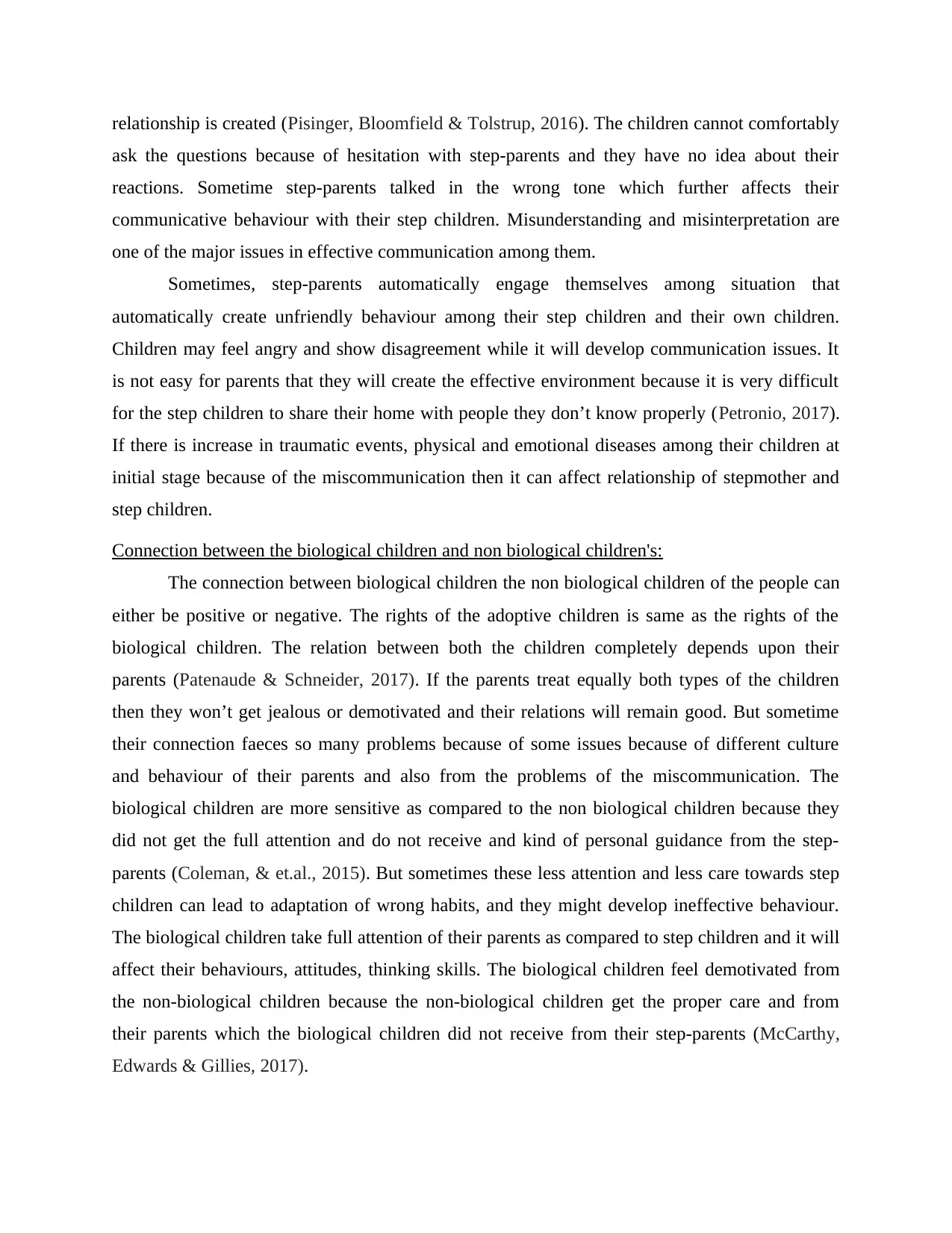
relationship is created (Pisinger, Bloomfield & Tolstrup, 2016). The children cannot comfortably
ask the questions because of hesitation with step-parents and they have no idea about their
reactions. Sometime step-parents talked in the wrong tone which further affects their
communicative behaviour with their step children. Misunderstanding and misinterpretation are
one of the major issues in effective communication among them.
Sometimes, step-parents automatically engage themselves among situation that
automatically create unfriendly behaviour among their step children and their own children.
Children may feel angry and show disagreement while it will develop communication issues. It
is not easy for parents that they will create the effective environment because it is very difficult
for the step children to share their home with people they don’t know properly (Petronio, 2017).
If there is increase in traumatic events, physical and emotional diseases among their children at
initial stage because of the miscommunication then it can affect relationship of stepmother and
step children.
Connection between the biological children and non biological children's:
The connection between biological children the non biological children of the people can
either be positive or negative. The rights of the adoptive children is same as the rights of the
biological children. The relation between both the children completely depends upon their
parents (Patenaude & Schneider, 2017). If the parents treat equally both types of the children
then they won’t get jealous or demotivated and their relations will remain good. But sometime
their connection faeces so many problems because of some issues because of different culture
and behaviour of their parents and also from the problems of the miscommunication. The
biological children are more sensitive as compared to the non biological children because they
did not get the full attention and do not receive and kind of personal guidance from the step-
parents (Coleman, & et.al., 2015). But sometimes these less attention and less care towards step
children can lead to adaptation of wrong habits, and they might develop ineffective behaviour.
The biological children take full attention of their parents as compared to step children and it will
affect their behaviours, attitudes, thinking skills. The biological children feel demotivated from
the non-biological children because the non-biological children get the proper care and from
their parents which the biological children did not receive from their step-parents (McCarthy,
Edwards & Gillies, 2017).
ask the questions because of hesitation with step-parents and they have no idea about their
reactions. Sometime step-parents talked in the wrong tone which further affects their
communicative behaviour with their step children. Misunderstanding and misinterpretation are
one of the major issues in effective communication among them.
Sometimes, step-parents automatically engage themselves among situation that
automatically create unfriendly behaviour among their step children and their own children.
Children may feel angry and show disagreement while it will develop communication issues. It
is not easy for parents that they will create the effective environment because it is very difficult
for the step children to share their home with people they don’t know properly (Petronio, 2017).
If there is increase in traumatic events, physical and emotional diseases among their children at
initial stage because of the miscommunication then it can affect relationship of stepmother and
step children.
Connection between the biological children and non biological children's:
The connection between biological children the non biological children of the people can
either be positive or negative. The rights of the adoptive children is same as the rights of the
biological children. The relation between both the children completely depends upon their
parents (Patenaude & Schneider, 2017). If the parents treat equally both types of the children
then they won’t get jealous or demotivated and their relations will remain good. But sometime
their connection faeces so many problems because of some issues because of different culture
and behaviour of their parents and also from the problems of the miscommunication. The
biological children are more sensitive as compared to the non biological children because they
did not get the full attention and do not receive and kind of personal guidance from the step-
parents (Coleman, & et.al., 2015). But sometimes these less attention and less care towards step
children can lead to adaptation of wrong habits, and they might develop ineffective behaviour.
The biological children take full attention of their parents as compared to step children and it will
affect their behaviours, attitudes, thinking skills. The biological children feel demotivated from
the non-biological children because the non-biological children get the proper care and from
their parents which the biological children did not receive from their step-parents (McCarthy,
Edwards & Gillies, 2017).
Paraphrase This Document
Need a fresh take? Get an instant paraphrase of this document with our AI Paraphraser
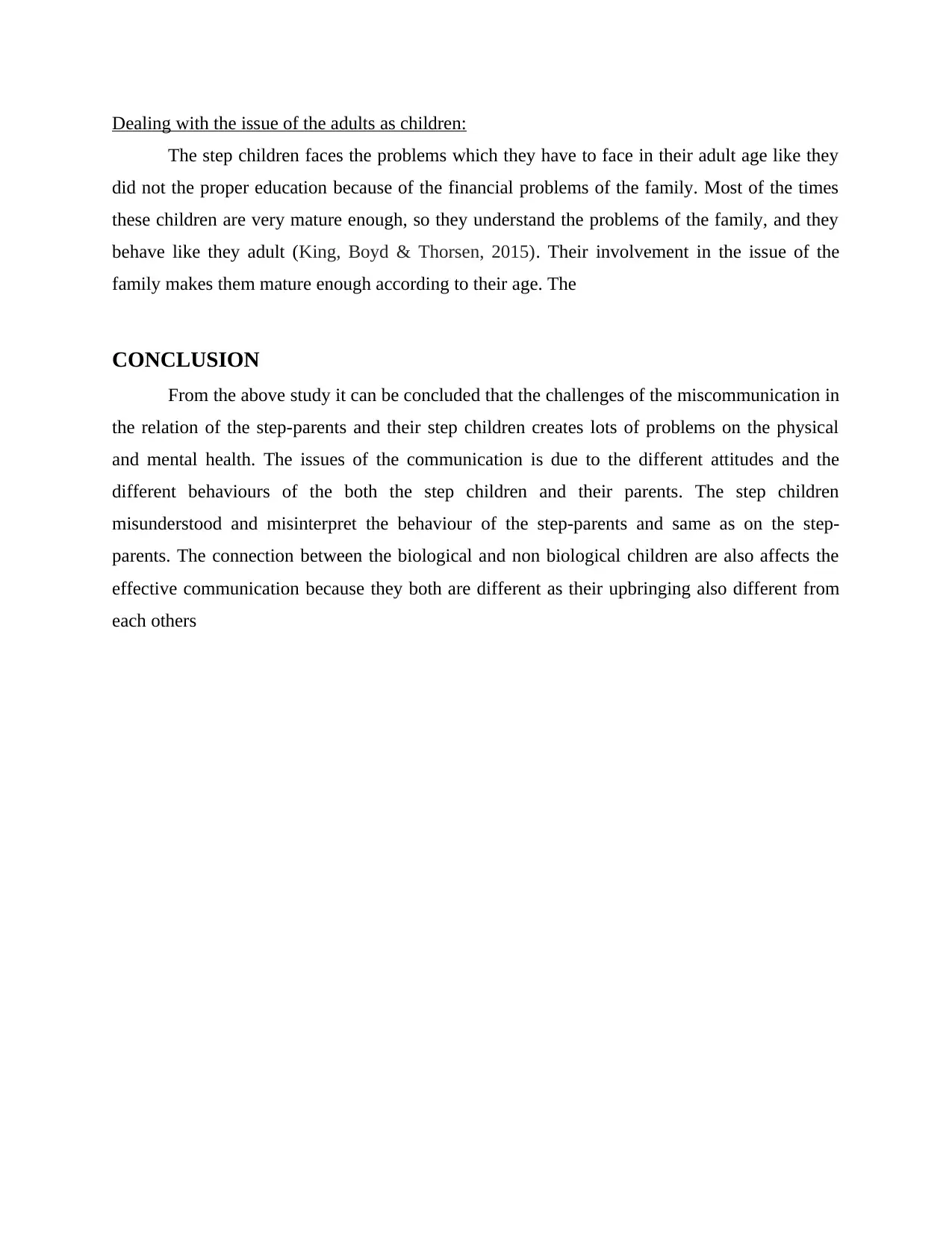
Dealing with the issue of the adults as children:
The step children faces the problems which they have to face in their adult age like they
did not the proper education because of the financial problems of the family. Most of the times
these children are very mature enough, so they understand the problems of the family, and they
behave like they adult (King, Boyd & Thorsen, 2015). Their involvement in the issue of the
family makes them mature enough according to their age. The
CONCLUSION
From the above study it can be concluded that the challenges of the miscommunication in
the relation of the step-parents and their step children creates lots of problems on the physical
and mental health. The issues of the communication is due to the different attitudes and the
different behaviours of the both the step children and their parents. The step children
misunderstood and misinterpret the behaviour of the step-parents and same as on the step-
parents. The connection between the biological and non biological children are also affects the
effective communication because they both are different as their upbringing also different from
each others
The step children faces the problems which they have to face in their adult age like they
did not the proper education because of the financial problems of the family. Most of the times
these children are very mature enough, so they understand the problems of the family, and they
behave like they adult (King, Boyd & Thorsen, 2015). Their involvement in the issue of the
family makes them mature enough according to their age. The
CONCLUSION
From the above study it can be concluded that the challenges of the miscommunication in
the relation of the step-parents and their step children creates lots of problems on the physical
and mental health. The issues of the communication is due to the different attitudes and the
different behaviours of the both the step children and their parents. The step children
misunderstood and misinterpret the behaviour of the step-parents and same as on the step-
parents. The connection between the biological and non biological children are also affects the
effective communication because they both are different as their upbringing also different from
each others
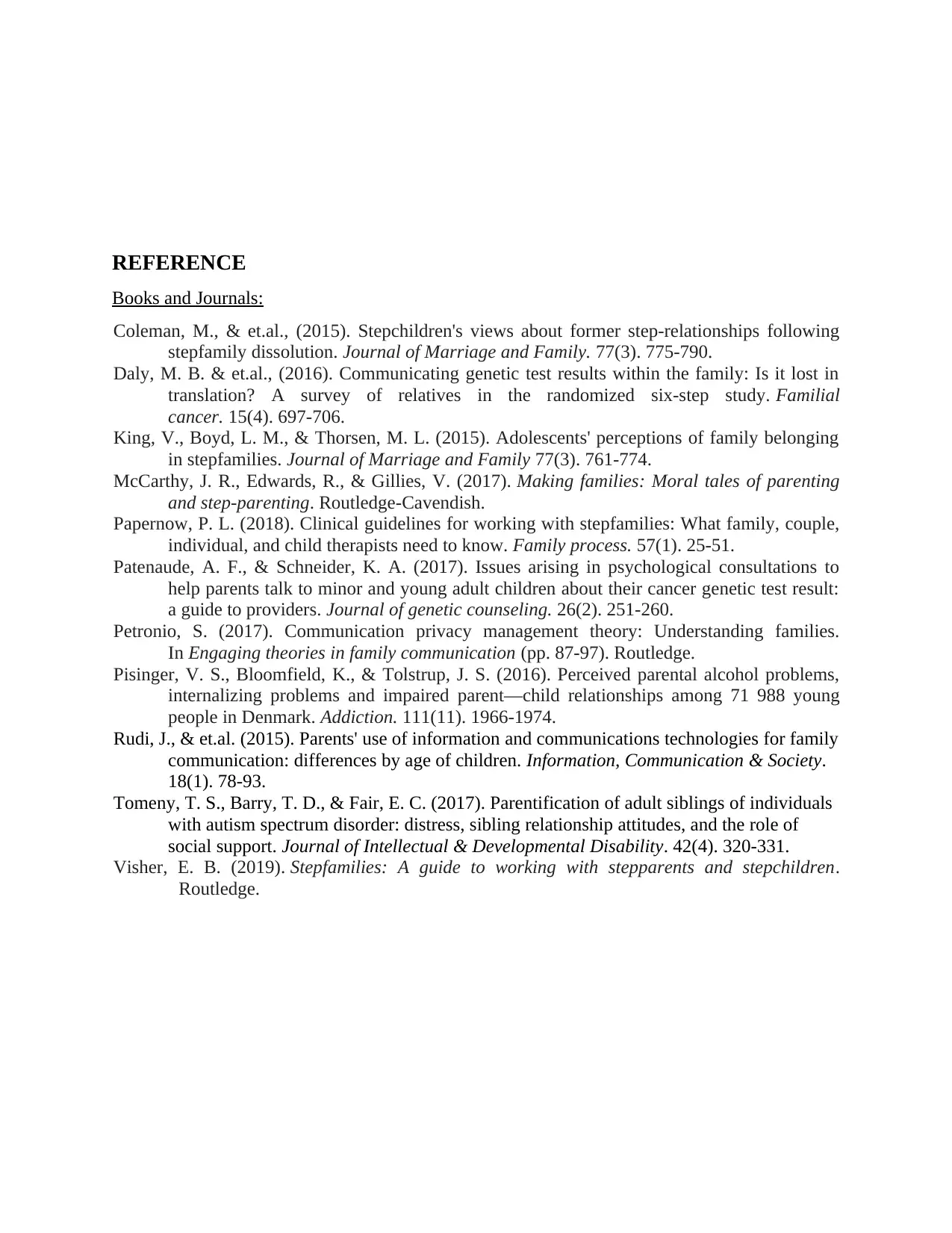
REFERENCE
Books and Journals:
Coleman, M., & et.al., (2015). Stepchildren's views about former step‐relationships following
stepfamily dissolution. Journal of Marriage and Family. 77(3). 775-790.
Daly, M. B. & et.al., (2016). Communicating genetic test results within the family: Is it lost in
translation? A survey of relatives in the randomized six-step study. Familial
cancer. 15(4). 697-706.
King, V., Boyd, L. M., & Thorsen, M. L. (2015). Adolescents' perceptions of family belonging
in stepfamilies. Journal of Marriage and Family 77(3). 761-774.
McCarthy, J. R., Edwards, R., & Gillies, V. (2017). Making families: Moral tales of parenting
and step-parenting. Routledge-Cavendish.
Papernow, P. L. (2018). Clinical guidelines for working with stepfamilies: What family, couple,
individual, and child therapists need to know. Family process. 57(1). 25-51.
Patenaude, A. F., & Schneider, K. A. (2017). Issues arising in psychological consultations to
help parents talk to minor and young adult children about their cancer genetic test result:
a guide to providers. Journal of genetic counseling. 26(2). 251-260.
Petronio, S. (2017). Communication privacy management theory: Understanding families.
In Engaging theories in family communication (pp. 87-97). Routledge.
Pisinger, V. S., Bloomfield, K., & Tolstrup, J. S. (2016). Perceived parental alcohol problems,
internalizing problems and impaired parent—child relationships among 71 988 young
people in Denmark. Addiction. 111(11). 1966-1974.
Rudi, J., & et.al. (2015). Parents' use of information and communications technologies for family
communication: differences by age of children. Information, Communication & Society.
18(1). 78-93.
Tomeny, T. S., Barry, T. D., & Fair, E. C. (2017). Parentification of adult siblings of individuals
with autism spectrum disorder: distress, sibling relationship attitudes, and the role of
social support. Journal of Intellectual & Developmental Disability. 42(4). 320-331.
Visher, E. B. (2019). Stepfamilies: A guide to working with stepparents and stepchildren.
Routledge.
Books and Journals:
Coleman, M., & et.al., (2015). Stepchildren's views about former step‐relationships following
stepfamily dissolution. Journal of Marriage and Family. 77(3). 775-790.
Daly, M. B. & et.al., (2016). Communicating genetic test results within the family: Is it lost in
translation? A survey of relatives in the randomized six-step study. Familial
cancer. 15(4). 697-706.
King, V., Boyd, L. M., & Thorsen, M. L. (2015). Adolescents' perceptions of family belonging
in stepfamilies. Journal of Marriage and Family 77(3). 761-774.
McCarthy, J. R., Edwards, R., & Gillies, V. (2017). Making families: Moral tales of parenting
and step-parenting. Routledge-Cavendish.
Papernow, P. L. (2018). Clinical guidelines for working with stepfamilies: What family, couple,
individual, and child therapists need to know. Family process. 57(1). 25-51.
Patenaude, A. F., & Schneider, K. A. (2017). Issues arising in psychological consultations to
help parents talk to minor and young adult children about their cancer genetic test result:
a guide to providers. Journal of genetic counseling. 26(2). 251-260.
Petronio, S. (2017). Communication privacy management theory: Understanding families.
In Engaging theories in family communication (pp. 87-97). Routledge.
Pisinger, V. S., Bloomfield, K., & Tolstrup, J. S. (2016). Perceived parental alcohol problems,
internalizing problems and impaired parent—child relationships among 71 988 young
people in Denmark. Addiction. 111(11). 1966-1974.
Rudi, J., & et.al. (2015). Parents' use of information and communications technologies for family
communication: differences by age of children. Information, Communication & Society.
18(1). 78-93.
Tomeny, T. S., Barry, T. D., & Fair, E. C. (2017). Parentification of adult siblings of individuals
with autism spectrum disorder: distress, sibling relationship attitudes, and the role of
social support. Journal of Intellectual & Developmental Disability. 42(4). 320-331.
Visher, E. B. (2019). Stepfamilies: A guide to working with stepparents and stepchildren.
Routledge.
⊘ This is a preview!⊘
Do you want full access?
Subscribe today to unlock all pages.

Trusted by 1+ million students worldwide
1 out of 6
Related Documents
Your All-in-One AI-Powered Toolkit for Academic Success.
+13062052269
info@desklib.com
Available 24*7 on WhatsApp / Email
![[object Object]](/_next/static/media/star-bottom.7253800d.svg)
Unlock your academic potential
Copyright © 2020–2025 A2Z Services. All Rights Reserved. Developed and managed by ZUCOL.





